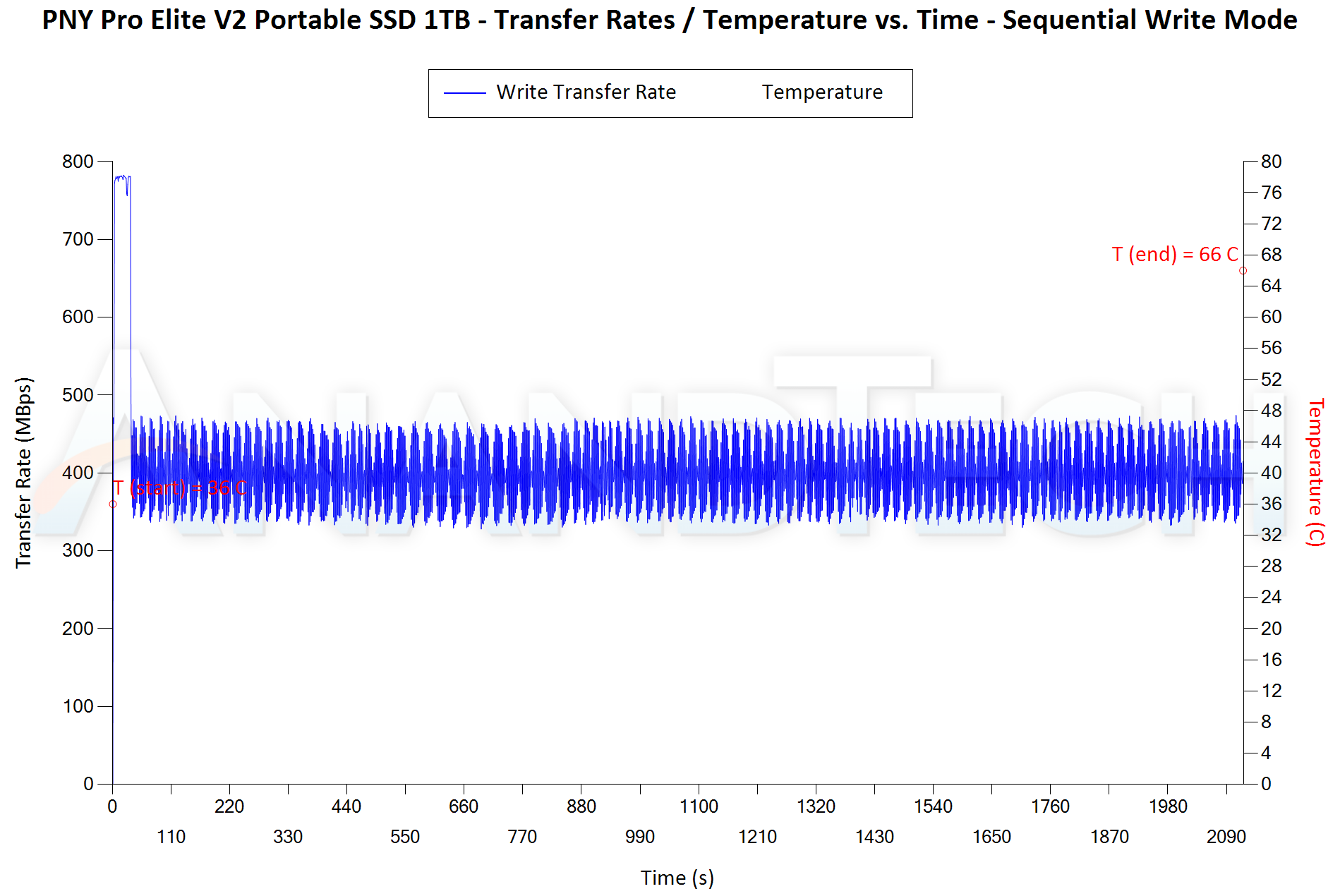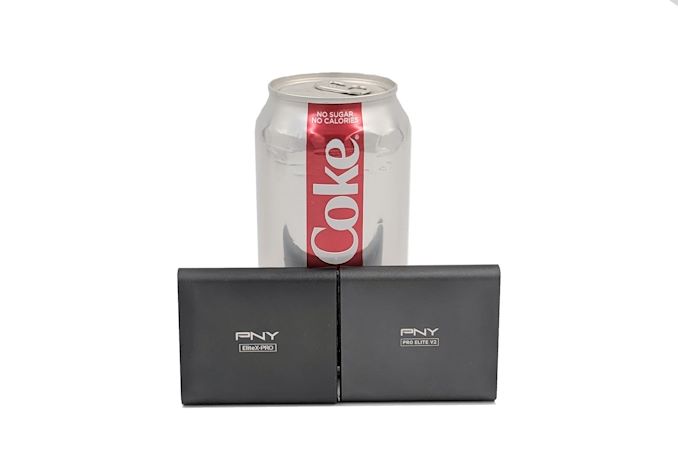PNY Pro Elite V2 and Elite-X PRO Portable SSDs Review: Performance on a Budget
by Ganesh T S on June 30, 2023 8:00 AM ESTMiscellaneous Aspects and Concluding Remarks
The performance of the PNY Pro Elite V2 and the EliteX-PRO in various real-world access traces as well as synthetic workloads was brought out in the preceding sections. We also looked at the performance consistency for these cases. Power users may also be interested in performance consistency under worst-case conditions, as well as drive power consumption. The latter is also important when used with battery powered devices such as notebooks and smartphones. Pricing is also an important aspect. We analyze each of these in detail below.
Worst-Case Performance Consistency
Flash-based storage devices tend to slow down in unpredictable ways when subject to a large number of small-sized random writes. Many benchmarks use that scheme to pre-condition devices prior to the actual testing in order to get a worst-case representative number. Fortunately, such workloads are uncommon for direct-attached storage devices, where workloads are largely sequential in nature. Use of SLC caching as well as firmware caps to prevent overheating may cause drop in write speeds when a flash-based DAS device is subject to sustained sequential writes.
Our Sequential Writes Performance Consistency Test configures the device as a raw physical disk (after deleting configured volumes). A fio workload is set up to write sequential data to the raw drive with a block size of 128K and iodepth of 32 to cover 90% of the drive capacity. The internal temperature is recorded at either end of the workload, while the instantaneous write data rate and cumulative total write data amount are recorded at 1-second intervals.
| Sequential Writes to 90% Capacity - Performance Consistency [ 1 TB PSSDs] | |
| TOP: | BOTTOM: |
 |
|
 |
|
The Pro Elite V2 can sustain around 400 MBps after its SLC cache of around 25 GB gets exhausted. The behavior is much better than the OWC Envoy Pro Mini based on the same controller. Bridge-based solutions are obviously better, but the two U17 PSSDs perform better in this test compared to the SM2320-based ones. The temperature at the end of the process is 66C. Many other PSSDs are cooler at the end of this test, but they contain proper thermal solutions.
| Sequential Writes to 90% Capacity - Performance Consistency [ 4 TB PSSDs ] | |
| TOP: | BOTTOM: |
 |
|
 |
|
The absence of a proper thermal solution is a hindrance to the EliteX-PRO in this test. The Gen 2x2 PSSD can sustain only 300 MBps, and the 25 GB SLC cache runs out in as little as 17s due to the 1550 MBps initial fill-up. It is unclear why the SLC cache is sized this way for a 4 TB drive. The temperature is also a toasty 76C at the end of the process. The SanDisk PSSD with its stellar thermal solution is the star of the show in this workload.
Power Consumption
Bus-powered devices can configure themselves to operate within the power delivery constraints of the host port. While Thunderbolt ports are guaranteed to supply up to 15W for client devices, USB 2.0 ports are guaranteed to deliver only 4.5W (900mA @ 5V). In this context, it is interesting to have a fine-grained look at the power consumption profile of the various external drives. Using the Plugable USBC-TKEY, the bus power consumption of the drives was tracked while processing the CrystalDiskMark workloads (separated by 5s intervals). The graphs below plot the instantaneous bus power consumption against time, while singling out the maximum and minimum power consumption numbers.
| CrystalDiskMark Workloads - Power Consumption [ 1 TB PSSDs ] | |
| TOP: | BOTTOM: |
 |
|
 |
|
The bridge-based solutions consume more power than the native UFD controller ones, as expected. The OWC Envoy Pro Mini is the best of the lot, peaking at just 1.83W, while the PNY Pro Elite V2 clocks in at 2.75W. The good aspect is that the PSSD enters a deep sleep 0W power consumption state after around 20 minutes of idling. There is some garbage collection in the idle period that causes the drive to burn power when it is not expected to.
| CrystalDiskMark Workloads - Power Consumption [ 4 TB PSSDs ] | |
| TOP: | BOTTOM: |
 |
|
 |
|
Unlike the bridge-based solutions, the EliteX-PRO can hit a true zero deep sleep state. Peak power consumption is 4.9W, but that is way lower than the 7.23W of the SanDisk Extreme Pro V2. This is only to be expected given the presence of four flash packages as well as the high speeds (1550 MBps) to the external host. Samsung's T7 Shield possesses a comprehensive thermal solution despite its peak power consumption being only 4W. PNY needs to equip the EliteX-PRO with additional support to handle the heat output.
Final Words
The PNY Pro Elite V2 and EliteX-PRO have been available in the market for a few months now. The 1 TB version of the Pro Elite V2 has a current street price of $70, while the 4 TB version of the EliteX-PRO is available for $300. At the Pro Elite V2's current price point, the main competition is the Transcend ESD310C. However, the two products target different market segments / consumer types. There is not much to complain on that front. The EliteX-PRO's pricing analysis is not quite that straightforward. The 4 TB T7 Shield is priced at $260, but it is a Gen 2 device. The SanDisk Extreme PRO v2 is also priced at $300, and has a much better performance profile and stands up well to sustained stress. However, the EliteX-PRO consumes much less power. On balance, the EliteX-PRO can be said to provide value only if it is priced lower than the SanDisk Extreme PRO v2.
Phison's native UFD controllers have been a bit of a mixed bag so far. Not being able to hit the interface speed limits and small SLC cache sizes (that is arguably an important aspect for direct-attached storage workloads) are some of the complaints that any reasonable user might want to file. Bridge-based solutions, despite their higher power consumption numbers, offer much better value. OWC was able to work around these problems in the Envoy Pro Mini by careful firmware tuning and creating a unique product in a thumb drive form factor. Unfortunately, the same can't be said of PNY's offerings. While the Pro Elite V2 offers compelling all-round value at $70, low-power operation is the only advantage for the EliteX-PRO. Consumers looking for a 4 TB off-the-shelf high-speed PSSD are better off with the SanDisk Extreme PRO v2 (or even the T7 Shield if 10 Gbps / Gen 2 speeds are enough).











4 Comments
View All Comments
garblah - Friday, June 30, 2023 - link
According to the box it supports 4K. That's good to know.But I suppose if you're designing the box art then your target audience is the average walk-in customer at Best Buy or Walmart.
PeachNCream - Tuesday, July 4, 2023 - link
To be fair, uninformed purchasing appears the norm in the US. Why else should marketing work so well on the average person if they'd done any research?evilspoons - Monday, July 10, 2023 - link
Some of your CrystalDiskMark device result screenshots are in IOPS and some are in MB/s. This makes the comparison between the OWC and Kingston 1 TB devices look incredibly lopsided on everything except the SEQ1M test.pipama09 - Wednesday, August 23, 2023 - link
hello